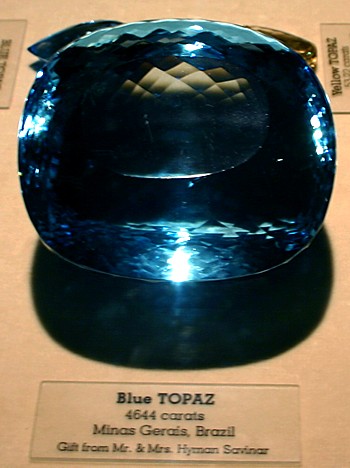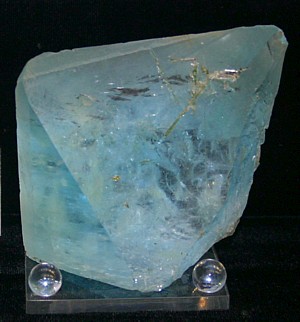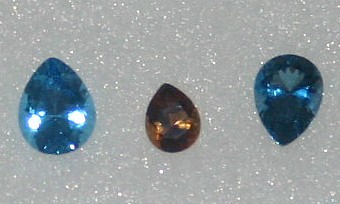Topaz: Shades of Blues and Oranges
Topaz, the November birthstone, occurs in a wide variety of hues, including blues, greens and many shades of orange and yellow to purplish pink. The most common form is the beautiful blue Topaz, which has its lovely pale to medium blue color created by exposure to irradiation. The rarest of all the topaz colors is the rich, intense orange to pink that in Victorian times became known as "Imperial topaz". The little town of Ouro Preto in the state of Minas Gerais, Brazil, is the only locality in which commercially significant deposits of precious topaz are found. No other locality, no other country produces this Imperial version of Topaz. Pale pink topaz comes from Pakistan, but the sizes are always quite small. Only Russia, in the days of the Czars, produced large pastel-pink gem material. This locality has long been exhausted, and large Imperial topazes are therefore found only in estate jewelry and old museum collections. Even this material is rare in sizes over 10 carats, and stones over 50 carats are virtually unknown. Smaller pink topaz gems are occasionally available, usually appearing in Europe. It is not unusual to have them re-cut to modern proportions, to achieve maximum brilliancy and color. Such gems are greatly prized because of their great rarity and incredible beauty.
Topaz is the hardest of all silicate minerals. It does posses a very
strong cleavage, which makes cutting and handling a challenge. As a result, it can be
split with a single blow, a trait it shares with diamond. As a result it should be
protected from hard knocks. Topaz forms some of the largest, well-terminated gem crystals
ever found - Colorless crystals exceeding 10 pounds are not particularly uncommon, and
pieces up to about 200 pounds are occasionally produced. These are normally irradiated, so
that a number of blue or colorless topaz gems weighing many pounds have been cut.
The photo at right shows a large gem topaz of over 4,600 carats - it is
several inches wide, and because of its size it appears to have a fairly
deep blue coloration. Topaz of
pink or imperial colors do not occur in such large sizes.

Most topaz is formed in pegmatite rock deposits, which when weathered
release topaz and other gems into alluvial deposits. Brazil is the largest producer of
fine gem quality Topaz, specifically in the state of Minas Gerias. The imperial version of
topaz was discovered there in the town of
Ouro Preto in 1735. The little town of Ouro
Preto in the state of Minas Gerais, Brazil, is the only locality in which commercially
significant deposits of precious topaz are found. No other locality, no other country
produces this Imperial version of Topaz. Pale pink topaz comes from Pakistan, but
the sizes are always quite small. Only Russia, in
the days of the Czars, produced large pastel-pink gem material. This locality has long been exhausted, and large
Imperial topazes are therefore found only in estate jewelry and old museum collections.
Even this material is rare in sizes over 10 carats, and stones over 50 carats are
virtually unknown. More recently fine quality Topaz has been mined in Pakistan and Russia. Large quantities of pale to colorless topaz
which occur in alluvial or gravel type deposits are found in Brazil, Sri Lanka, Nigeria,
and China. Some unique topaz is produced in Utah - it formed in vugs in volcanic rock and
has a sherry color that fades to colorless on long exposure to light. Rock
hounds dig regularly in the Utah topaz area and sometimes make some very
nice finds.
TREATMENTS FOR TOPAZ
Blue topaz, a very common stone in many jewelry stores, is probably the most common stone likely to be treated by exposure to radiation. Some topaz is naturally blue colored, but probably 99% of all the blue material so common in commercial jewelry stores is created by treatment of colorless material using high-energy radiation and then heated to moderate temperatures to give its characteristic blue tone. Large quantities of pale to colorless topaz which can be enhanced by radiation to become blue is found in Brazil, Sri Lanka, Nigeria, and China. When stones treated by this process first appeared on the market, there was some concern about radiation remaining after treatment. Regulations have been established to protect the consumer and very little material with residual radiation now makes it into the marketplace. A heavy form of irradiation produces the deep "London Blue" tones. A pear shaped stone of London blue color is shown in the lower photo on the right.
In 1990s, a new type of enhanced topaz made its appearance. Not all colorless topaz can be enhanced to a good blue color. This situation left a large quantity of low value colorless topaz material on the market, with little demand for such gems. A special surface-enhancement treatment for topaz was developed to give the low value colorless material various colored appearances. Some has a rainbow type appearance and is called names Like “Mystique” with other colors described as blue to greenish-blue or emerald green. All of this surface treated topaz has it’s color only on the surface and if scratched or otherwise damaged, cannot be re-cut or repaired as can other types, since the surface color will be removed and only the original colorless stone will be left. It is far less valuable than even the irradiated blues, and is sold in many forms of inexpensive jewelry.
For more info on Topaz treatments, see my
treatment webpage at:
Gemstone Treatments: Topaz and Irradiation

